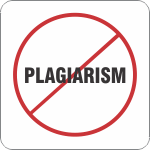Plagiarism Policy

By submitting articles to IJERT the author attest the following:
-
-
-
-
- None of the part of manuscript is plagiarized from other sources
- Proper reference is provided for all contents extracted from other sources
- Strong action will be taken against cases of plagiarism
-
-
-
All the papers submitted have to pass through an initial screening and will be checked through the Advanced Plagiarism Dectection Software (CrossCheck by iThenticate)
![]()

Duplication of text and/or figures
Plagiarism occurs when someone presents the work of others (data, text, or theories) as if it was his/her own without proper acknowledgment. There are different degrees of plagiarism.
The severity is dependent on various factors: extent of copied material, originality of copied material, position/context/type of material and referencing/attribution of the material used.
Every case is different and therefore decisions will vary per case. Ask yourself the following question: Does it concern an honest mistake or is there an intentional deviation from the scientific norm? Please note there are many grey areas between honest, questionable and fraudulent practices.
Whilst reviewing the case consider the following factors:
- Author seniority. Junior authors may be asked to paraphrase the copied text if it is believed that they are genuinely not aware that copying phrases is inappropriate. It is expected that a senior author should know better
- Cultural background could be an indication for potentially different behaviors concerning the amount of copying which could be seen as plagiarism
The following listing is designed to make you aware of the various possibilities concerning plagiarism:
- Verbatim copying of another’s work and submitting it as one’s own.
- Verbatim copying of significant portions of text from a single source.
- Mixing verbatim copied material from multiple sources (“patchwork copying”). This could range from 1 or 2 paragraphs to significant portions consisting of several paragraphs.
- Changing key words and phrases but retaining the essential content of the source as a framework.
- Rephrasing of the text’s original wording and/or structure and submitting it as one’s own.
- Mixing slightly rephrased material from multiple sources and presenting what has been published already as new.
- The work is cited, but the cited portions are not clearly identified. This can be combined with copied parts of text without citation.
However for review papers the above is not directly applicable. Review papers are expected to give a summary of existing literature. Authors should use their own words with exception of properly quoted and/or cited texts and the work should include a new interpretation.

